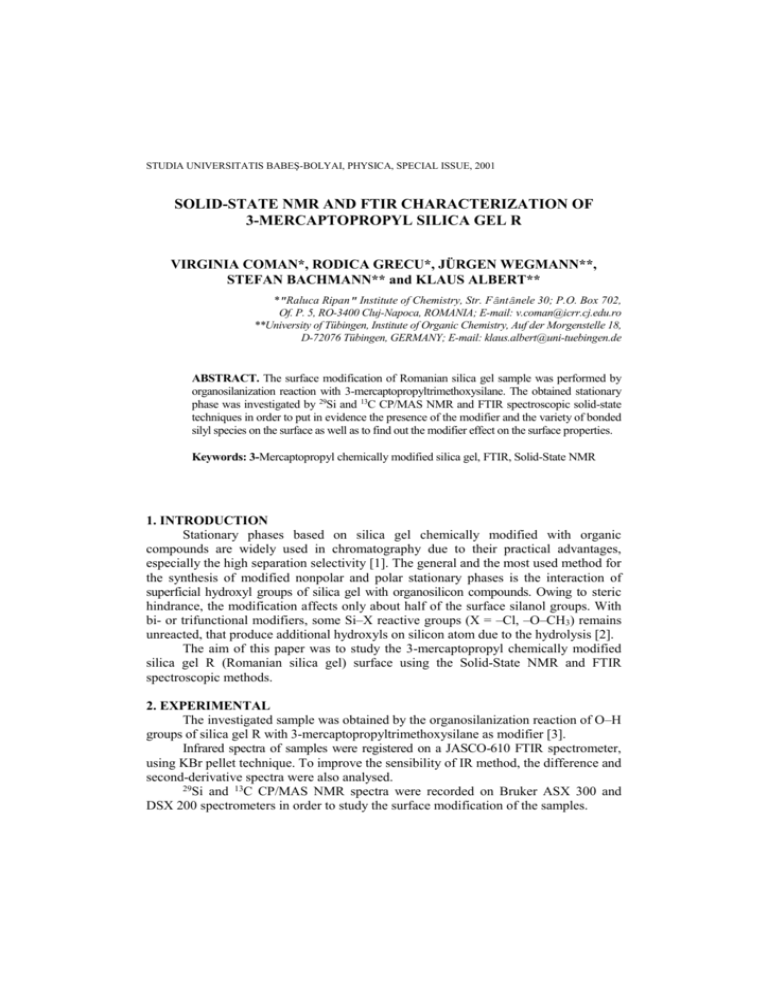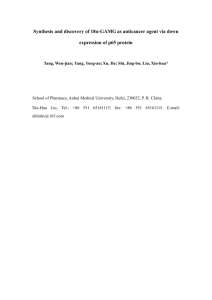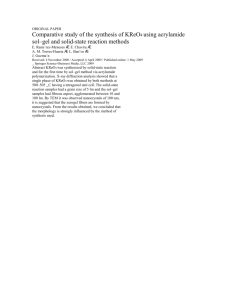3-MERCAPTOPROPYL Silica Gel R
advertisement

STUDIA UNIVERSITATIS BABEŞ-BOLYAI, PHYSICA, SPECIAL ISSUE, 2001 SOLID-STATE NMR AND FTIR CHARACTERIZATION OF 3-MERCAPTOPROPYL SILICA GEL R VIRGINIA COMAN*, RODICA GRECU*, JÜRGEN WEGMANN**, STEFAN BACHMANN** and KLAUS ALBERT** *"Raluca Ripan" Institute of Chemistry, Str. Fântânele 30; P.O. Box 702, Of. P. 5, RO-3400 Cluj-Napoca, ROMANIA; E-mail: v.coman@icrr.cj.edu.ro **University of Tübingen, Institute of Organic Chemistry, Auf der Morgenstelle 18, D-72076 Tübingen, GERMANY; E-mail: klaus.albert@uni-tuebingen.de ABSTRACT. The surface modification of Romanian silica gel sample was performed by organosilanization reaction with 3-mercaptopropyltrimethoxysilane. The obtained stationary phase was investigated by 29Si and 13C CP/MAS NMR and FTIR spectroscopic solid-state techniques in order to put in evidence the presence of the modifier and the variety of bonded silyl species on the surface as well as to find out the modifier effect on the surface properties. Keywords: 3-Mercaptopropyl chemically modified silica gel, FTIR, Solid-State NMR 1. INTRODUCTION Stationary phases based on silica gel chemically modified with organic compounds are widely used in chromatography due to their practical advantages, especially the high separation selectivity [1]. The general and the most used method for the synthesis of modified nonpolar and polar stationary phases is the interaction of superficial hydroxyl groups of silica gel with organosilicon compounds. Owing to steric hindrance, the modification affects only about half of the surface silanol groups. With bi- or trifunctional modifiers, some Si–X reactive groups (X = –Cl, –O–CH3) remains unreacted, that produce additional hydroxyls on silicon atom due to the hydrolysis [2]. The aim of this paper was to study the 3-mercaptopropyl chemically modified silica gel R (Romanian silica gel) surface using the Solid-State NMR and FTIR spectroscopic methods. 2. EXPERIMENTAL The investigated sample was obtained by the organosilanization reaction of O–H groups of silica gel R with 3-mercaptopropyltrimethoxysilane as modifier [3]. Infrared spectra of samples were registered on a JASCO-610 FTIR spectrometer, using KBr pellet technique. To improve the sensibility of IR method, the difference and second-derivative spectra were also analysed. 29Si and 13C CP/MAS NMR spectra were recorded on Bruker ASX 300 and DSX 200 spectrometers in order to study the surface modification of the samples. SOLID-STATE NMR AND FTIR CHARACTERIZATION OF 3-MERCAPTOPROPYL SILICA GEL R 3. RESULTS AND DISSCUSIONS The chemical modification of the silica gel surface is related to the presence of the free silanol groups (─Si─OH). The effects of silanization reaction are the reduction of the superficial ─OH group number and a greater variety of siloxane groups (─Si─O─Si─). For the studied compound, the following reaction takes place: CH3 OH SiO2 OH OH O + H3C O O Si CH2 CH2 CH2 SH O CH3OH SiO2 O Si CH2 CH2 CH2 SH O CH3 silica gel (inorganic support) 3-mercaptopropyltrimethoxysilane (trifunctional modifier) 3-mercaptopropyl silica gel (chemically modified stationary phase) 3.1. FTIR Study When the samples are prepared using the well-known method of KBr pellet, infrared data are useful only to confirm the existence of the bonded species. Due to the low concentration of the organic part of modifier on the surface, the intensity of the new bands attesting the presence of CH2 groups is weak. Hardly are observed any differences in the 2800–3000 cm–1 range, where (C─H) vibrations of the ─CH2─ groups are evidenced (Figure 1). In the difference spectrum of 3-mercaptopropyl modified and unmodified silica gel R samples (Figure 2), we can easy to identify the as(CH2) and sym(CH2) bands at 2930 cm–1 and respectively 2855 cm–1. The band at 2960 cm–1 is assigned to as(CH3) and this fact confirms that, due to steric reasons, the functionality of 3-mercaptopropyltrimethoxysilane is 2 and 3. Figure 1. FTIR spectra of the following samples: (------) 3-mercaptopropyltrimethoxysilane modifier (liquid film technique),(– – –) silica gel R (KBr pellet technique), (––––) 3-mercaptopropyl chemically modified silica gel R (KBr pellet technique). 327 VIRGINIA COMAN, RODICA GRECU, JÜRGEN WEGMANN, STEFAN BACHMANN, KLAUS ALBERT Figure 2. Difference FTIR spectrum of 3-mercaptopropyl modified and unmodified silica gel R samples. A disadvantage of infrared spectra lies in the interference of the strong absorption by the skeletal modes of unmodified silica (900-1300 cm–1) with the Si─O absorptions of silicoorganic part. However, there are some differences that reflect the effect of modifier and these could be evidenced comparing the second-derivatives of spectra of the unmodified and modified silica gel R samples (figure 3). Figure 3. Second–derivative FTIR spectra for unmodified (– – –) and 3-mercaptopropyl modified (–––) silica gel R samples. 328 SOLID-STATE NMR AND FTIR CHARACTERIZATION OF 3-MERCAPTOPROPYL SILICA GEL R 3.2. Solid-State NMR Study Valuable structural information about the silica gel and the chemically modified material can be obtained by means of Solid-State NMR spectroscopy. In solid state samples, due to the limited motion, strong dipolar-dipolar and chemical shift anisotropy interactions occur. The line broadening effects can be cancelled using magic angle spinning ( M AS ) technique. Other problems which arise in solid-state NMR spectroscopy related to the strong heteronuclear interactions and to the existence of very long spin-lattice relaxation times T1 of the order of minutes to hours are solved in the cross polarization ( CP ) technique [4]. Silane functionality according to the used silane type, bonding chemistry and the different surface species that result can be distinguished by 29Si and 13C CP/MAS NMR measurements. So, the monofunctional species (M) appear in the region from 13 to – 1 ppm, difunctional species (Dn) from –7 to –20 ppm, trifunctional species (Tn) from –49 to –66 ppm and signal from the starting silica gel from –91 to –110 ppm (Figure 4). A higher degree of cross-linking of silyl species and/or of oxygen neighbors leads to an upfield shift in NMR spectra. Figure 5 presents the 29Si CP/MAS NMR spectra of unmodified and 3-mercaptopropyl modified silica gel R. The spectrum of unmodified silica gel R contains the signals assigned to the Q species, Q2 (–91 ppm) and Q3 (–101 ppm) showing a high amount of free –OH groups on the surface. In the spectrum of 3-mercapto-propyl silica gel R one can be observed the signals of trifunctional species (Tn) assigned to T2 (–56 ppm) and T3 (–65 ppm) groups. The shoulder at –91 ppm is assigned to Q2-groups which are still available on the surface. The signal of the Q3-groups has a high intensity. This spectrum indicates a high cross linking on the modified surface and a lower surface coverage. Figure 4. Nomenclature and chemical shifts of some silyl species. 329 VIRGINIA COMAN, RODICA GRECU, JÜRGEN WEGMANN, STEFAN BACHMANN, KLAUS ALBERT Figure 5. 29Si CP/MAS NMR spectra of unmodified and 3-mercaptopropyl modified silica gel R samples. The 13C CP/MAS NMR spectrum of 3-mercaptopropyl modified silica gel R (Figure 6) indicates the presence of the modifier on the surface. Figure 6. 13C CP/MAS NMR spectrum of 3-mercaptopropyl modified silica gel R. 330 SOLID-STATE NMR AND FTIR CHARACTERIZATION OF 3-MERCAPTOPROPYL SILICA GEL R The high field shifted signal at 10 ppm belongs to the C-1 closest to the surface, in the neighborhood of the silicon. The signals at 23 and 27 ppm can be assigned to C-2 and C-3 carbons from 3-mercaptopropyl modifier. 4. CONCLUSIONS The presence of the 3-mercaptopropyl modifier on the surface of silica gel R was evidenced using FTIR and 13C CP/MAS NMR spectroscopic methods. The type of bonded silyl species resulted by the organosilanization reaction was investigated by 29Si CP/MAS NMR technique. It was established the presence of different silyl species on the chemically modified support and the coverage of surface according to the results obtained from the measurements of specific surface area [3]. R E FER EN CE S 1. 2. 3. 4. S.M. Staroverov and A.Yu. Fadeev, J. Chromatogr., 1991, 544, 77-98. S. Héron and A. Tchapla, Analusis, 1993, 21, 327-347. C. Măruţoiu, R. Constantinescu, F. Dogar and R. Grecu, J. AOAC Int., 1999, 82, 399-401. K. Albert and E. Bayer, J. Chromatogr., 1991, 544, 345-370. 331





